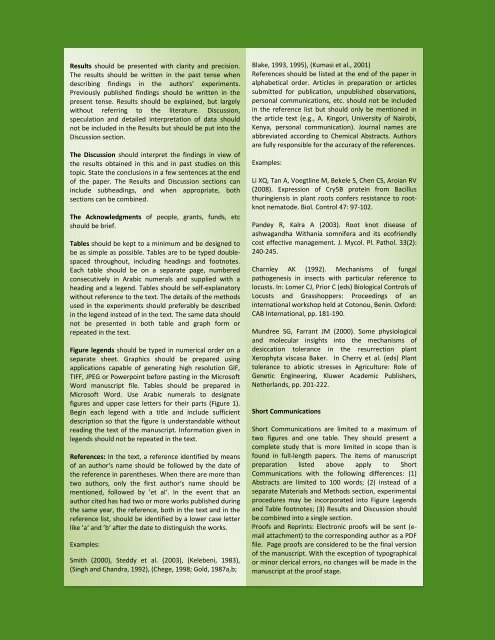Download Complete Issue - Academic Journals
Download Complete Issue - Academic Journals
Download Complete Issue - Academic Journals
Create successful ePaper yourself
Turn your PDF publications into a flip-book with our unique Google optimized e-Paper software.
Results should be presented with clarity and precision.<br />
The results should be written in the past tense when<br />
describing findings in the authors' experiments.<br />
Previously published findings should be written in the<br />
present tense. Results should be explained, but largely<br />
without referring to the literature. Discussion,<br />
speculation and detailed interpretation of data should<br />
not be included in the Results but should be put into the<br />
Discussion section.<br />
The Discussion should interpret the findings in view of<br />
the results obtained in this and in past studies on this<br />
topic. State the conclusions in a few sentences at the end<br />
of the paper. The Results and Discussion sections can<br />
include subheadings, and when appropriate, both<br />
sections can be combined.<br />
The Acknowledgments of people, grants, funds, etc<br />
should be brief.<br />
Tables should be kept to a minimum and be designed to<br />
be as simple as possible. Tables are to be typed doublespaced<br />
throughout, including headings and footnotes.<br />
Each table should be on a separate page, numbered<br />
consecutively in Arabic numerals and supplied with a<br />
heading and a legend. Tables should be self-explanatory<br />
without reference to the text. The details of the methods<br />
used in the experiments should preferably be described<br />
in the legend instead of in the text. The same data should<br />
not be presented in both table and graph form or<br />
repeated in the text.<br />
Figure legends should be typed in numerical order on a<br />
separate sheet. Graphics should be prepared using<br />
applications capable of generating high resolution GIF,<br />
TIFF, JPEG or Powerpoint before pasting in the Microsoft<br />
Word manuscript file. Tables should be prepared in<br />
Microsoft Word. Use Arabic numerals to designate<br />
figures and upper case letters for their parts (Figure 1).<br />
Begin each legend with a title and include sufficient<br />
description so that the figure is understandable without<br />
reading the text of the manuscript. Information given in<br />
legends should not be repeated in the text.<br />
References: In the text, a reference identified by means<br />
of an author‘s name should be followed by the date of<br />
the reference in parentheses. When there are more than<br />
two authors, only the first author‘s name should be<br />
mentioned, followed by ’et al‘. In the event that an<br />
author cited has had two or more works published during<br />
the same year, the reference, both in the text and in the<br />
reference list, should be identified by a lower case letter<br />
like ’a‘ and ’b‘ after the date to distinguish the works.<br />
Examples:<br />
Smith (2000), Steddy et al. (2003), (Kelebeni, 1983),<br />
(Singh and Chandra, 1992), (Chege, 1998; Gold, 1987a,b;<br />
Blake, 1993, 1995), (Kumasi et al., 2001)<br />
References should be listed at the end of the paper in<br />
alphabetical order. Articles in preparation or articles<br />
submitted for publication, unpublished observations,<br />
personal communications, etc. should not be included<br />
in the reference list but should only be mentioned in<br />
the article text (e.g., A. Kingori, University of Nairobi,<br />
Kenya, personal communication). Journal names are<br />
abbreviated according to Chemical Abstracts. Authors<br />
are fully responsible for the accuracy of the references.<br />
Examples:<br />
Li XQ, Tan A, Voegtline M, Bekele S, Chen CS, Aroian RV<br />
(2008). Expression of Cry5B protein from Bacillus<br />
thuringiensis in plant roots confers resistance to rootknot<br />
nematode. Biol. Control 47: 97-102.<br />
Pandey R, Kalra A (2003). Root knot disease of<br />
ashwagandha Withania somnifera and its ecofriendly<br />
cost effective management. J. Mycol. Pl. Pathol. 33(2):<br />
240-245.<br />
Charnley AK (1992). Mechanisms of fungal<br />
pathogenesis in insects with particular reference to<br />
locusts. In: Lomer CJ, Prior C (eds) Biological Controls of<br />
Locusts and Grasshoppers: Proceedings of an<br />
international workshop held at Cotonou, Benin. Oxford:<br />
CAB International, pp. 181-190.<br />
Mundree SG, Farrant JM (2000). Some physiological<br />
and molecular insights into the mechanisms of<br />
desiccation tolerance in the resurrection plant<br />
Xerophyta viscasa Baker. In Cherry et al. (eds) Plant<br />
tolerance to abiotic stresses in Agriculture: Role of<br />
Genetic Engineering, Kluwer <strong>Academic</strong> Publishers,<br />
Netherlands, pp. 201-222.<br />
Short Communications<br />
Short Communications are limited to a maximum of<br />
two figures and one table. They should present a<br />
complete study that is more limited in scope than is<br />
found in full-length papers. The items of manuscript<br />
preparation listed above apply to Short<br />
Communications with the following differences: (1)<br />
Abstracts are limited to 100 words; (2) instead of a<br />
separate Materials and Methods section, experimental<br />
procedures may be incorporated into Figure Legends<br />
and Table footnotes; (3) Results and Discussion should<br />
be combined into a single section.<br />
Proofs and Reprints: Electronic proofs will be sent (email<br />
attachment) to the corresponding author as a PDF<br />
file. Page proofs are considered to be the final version<br />
of the manuscript. With the exception of typographical<br />
or minor clerical errors, no changes will be made in the<br />
manuscript at the proof stage.

















